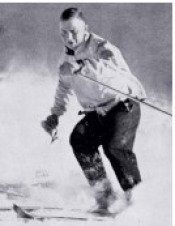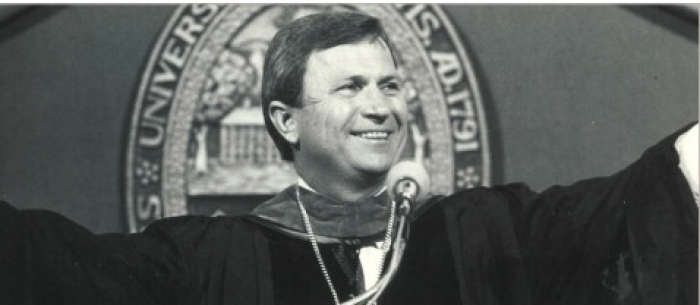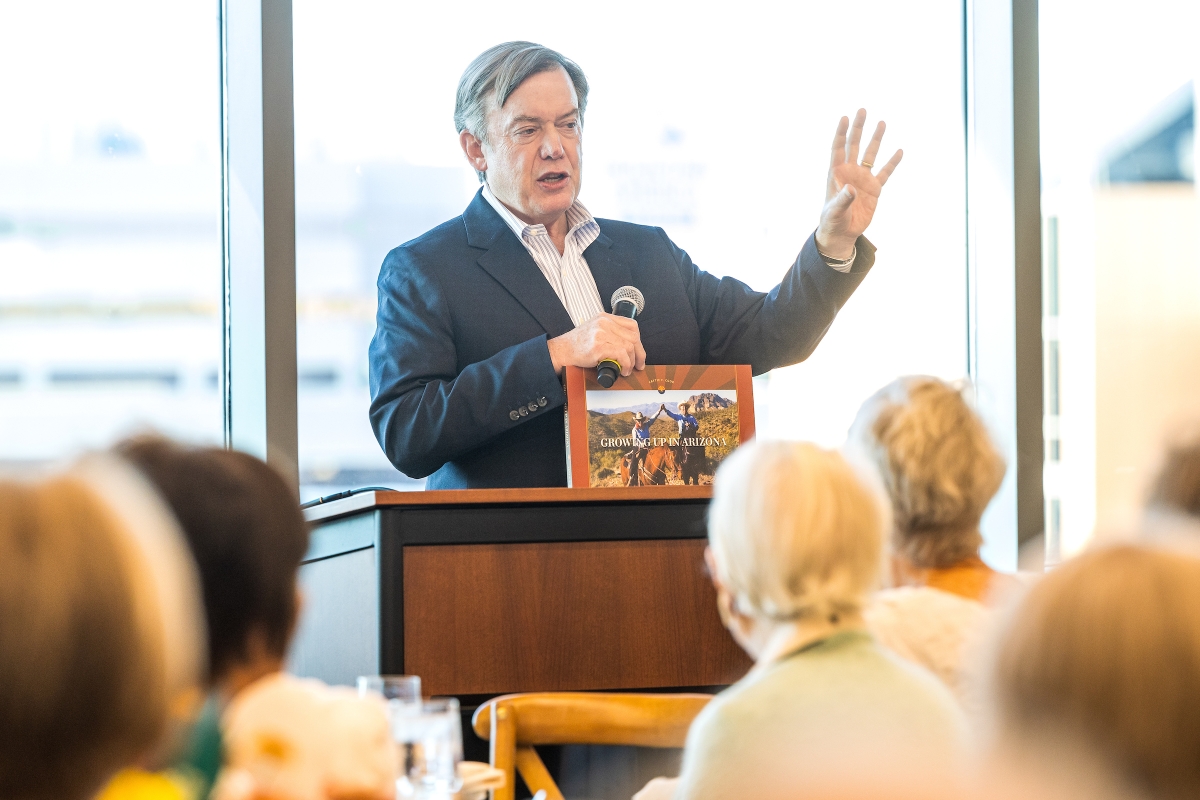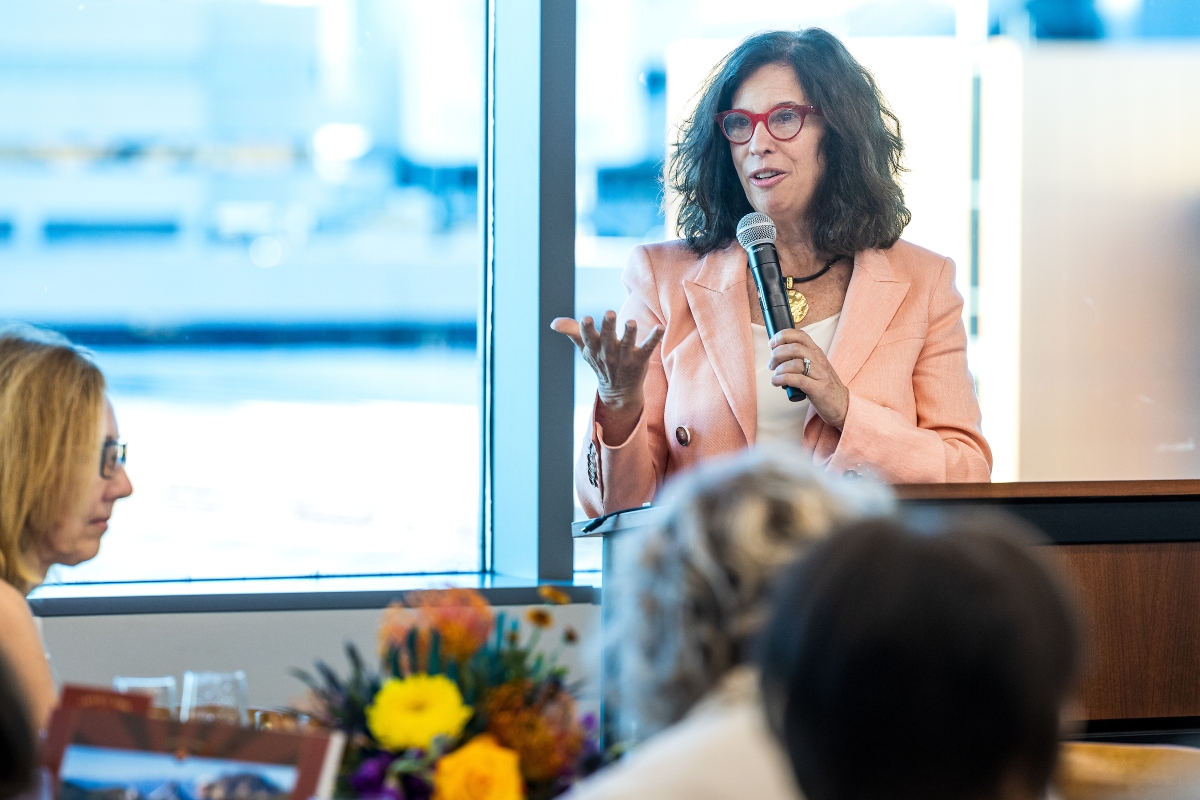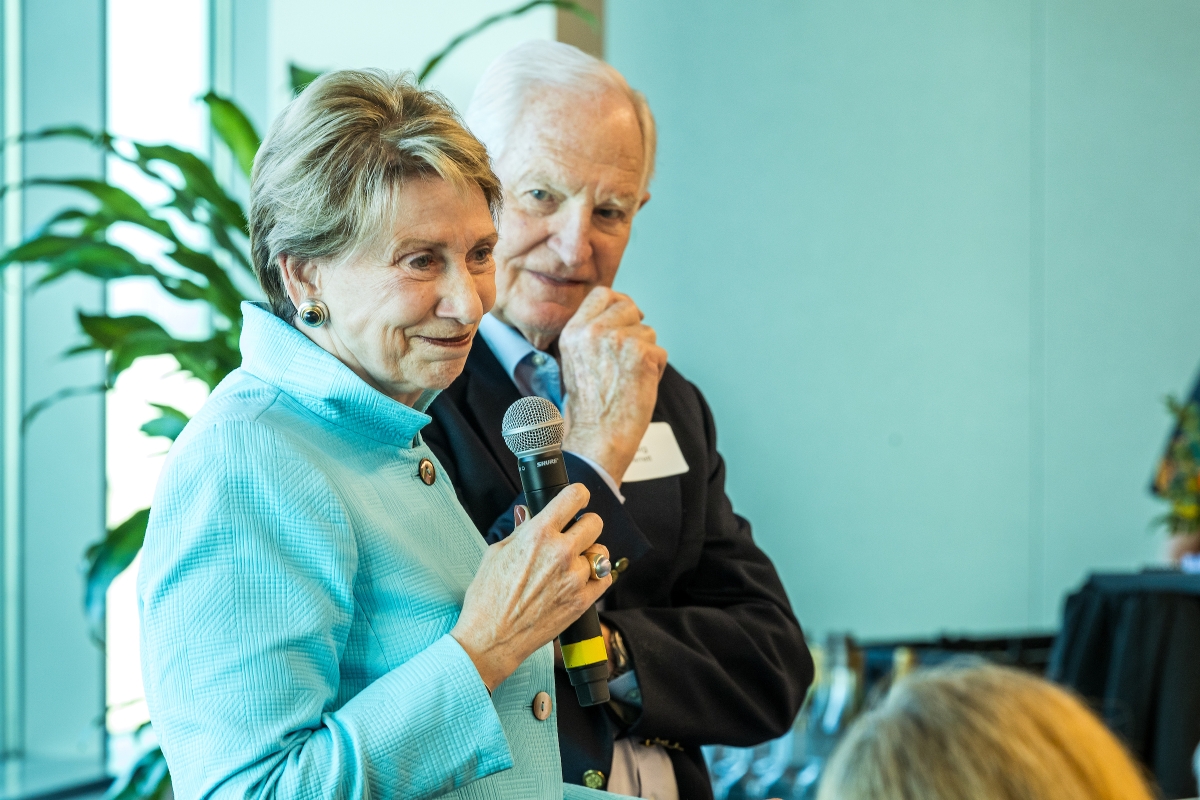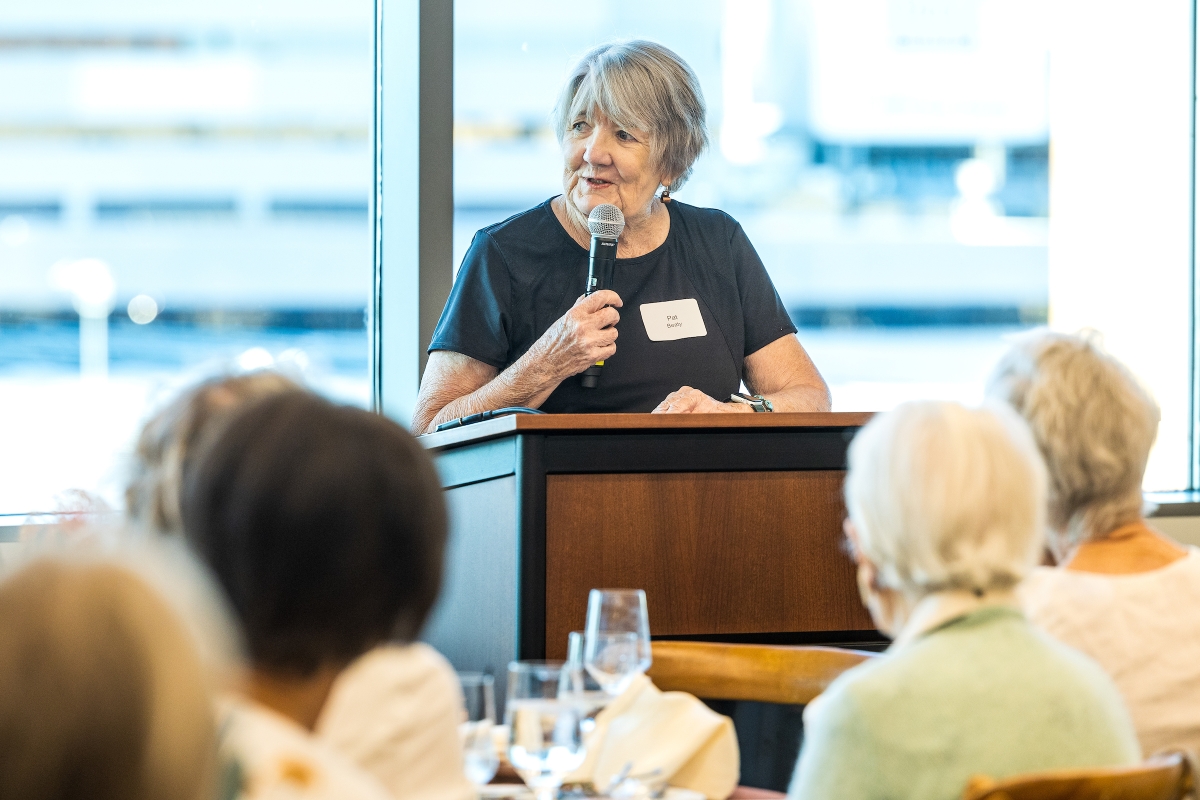Lattie Coor reflects on lifetime of love for Arizona, ASU in new memoir
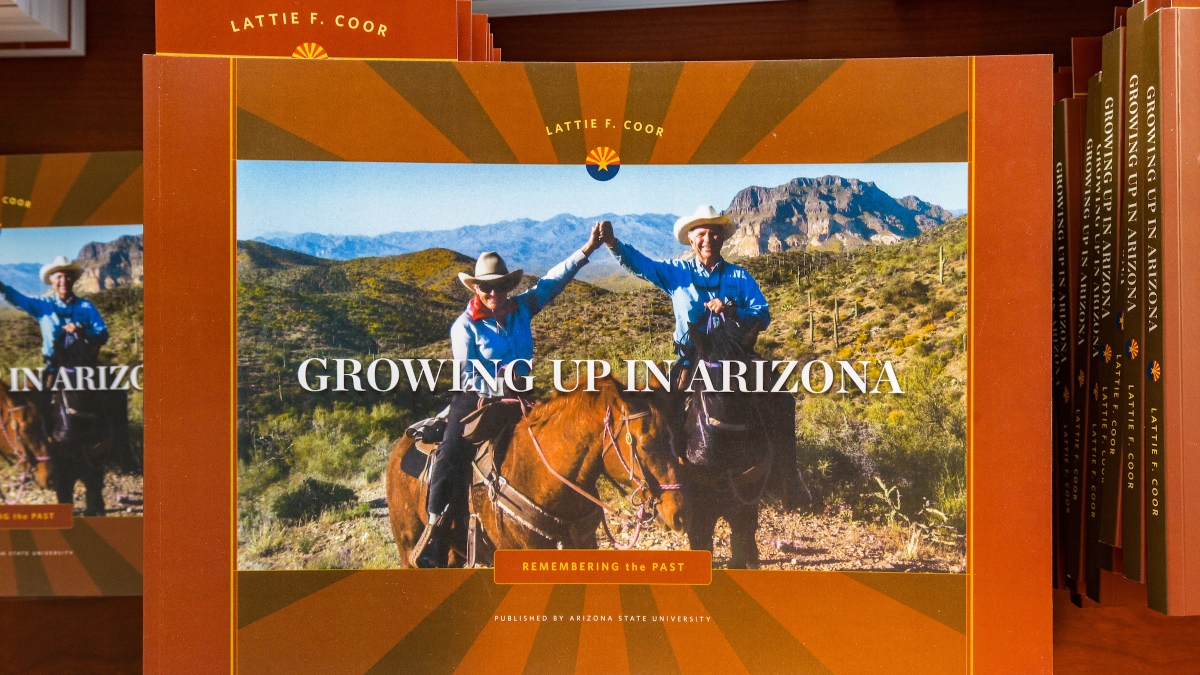
Guests received copies of “Growing Up in Arizona: Remembering the Past,” written by former ASU President Lattie Coor with excerpts from his friends and colleagues, at a reception celebrating its publishing on June 17. Photo by Charlie Leight/ASU News
Lattie Coor sees his home state of Arizona as a beautiful place of endless opportunity, and as president of Arizona State University, he worked to make sure the people of Arizona saw the university that way too.
Coor traces his history and years of public service in a new book, “Growing Up In Arizona: Remembering the Past,” published by ASU.
He served as president of ASU from 1990 to 2002. Under his 12-year tenure, ASU launched Barrett, The Honors College, established the Polytechnic campus and raised more than $560 million in the ASU Campaign for Leadership, increasing the number of endowed faculty chairs from six to 80.
In a major milestone, ASU earned Research I status in 1994 from the Carnegie Foundation for the Advancement of Teaching.
Coor worked to increase access to the university to underrepresented groups and to boost graduation rates, writing, “Until we help the university and this state ensure that every background, by race, ethnicity and gender is fully represented of the mainstream of our society, we cannot rest.”
In the foreword, Coor describes how, in 2018, he was invited to write the book by Michael Crow, who succeeded Coor as president of ASU in 2002. Coor began recording his memories and, a few years later, dozens of colleagues and friends were interviewed to add to his story.
“Growing Up In Arizona: Remembering the Past” lives in digital form on the ASU website, under the Office of the President.
Filled with Coor’s reflections on his life and Arizona’s history — plus plenty of old photographs — the book shines with Coor’s affection for his home state and ASU.
Coor worked tirelessly to change hearts and minds about the value of ASU. In the book, he wrote about how, in his inaugural address, he described ASU as a “world-class university,” and his feelings about that at retirement:
“I guess what I’m most gratified about is that I think people now believe it. They don’t think that it would be inappropriate or uppity to say we’re going to be a world-class university.”
At a book-launch event held by the ASU Foundation on June 17, university officials and friends of Lattie and Elva Coor shared memories.
Barbara Barrett, former secretary of the Air Force and ambassador to Finland, and Craig Barrett, former CEO of Intel, recalled their 30-year friendship with the Coors.
“They elevated our campus, they recruited outstanding talent, they engaged the community in unprecedented ways,” Barbara Barrett said. Barrett, The Honors College at ASU is named for her and husband Craig.
“Lattie and Elva masterminded the capital campaign that said, ‘This university is worthy.’ The community supported, endorsed this university,” she said.
In memoriam
Crow credited Coor with paving the way for the New American University, Crow’s vision for ASU.
“Lattie was the person who laid the framework for ASU to be a great research university,” Crow said.
“We’re still here advancing this model of how you build the great public university for Arizona, and Lattie has been unbelievably powerful in helping to make those things happen.”
For years, we went across the Salt River to watch football games and then back across to go home. That was our only connection to ASU. That’s the way most people thought about ASU until Lattie became president.
Dinky SnellFormer chair of the ASU Foundation Board of Directors and co-chair of the ASU Campaign for Leadership during Coor’s presidency, quoted in "Growing Up In Arizona"
ASU as a treasure
Coor was born in Phoenix in 1936, just 24 years after Arizona became a state. Coor’s family lived in Avondale and his parents were elementary school teachers. Later, his father was principal and superintendent in the district.
In the book, he shares some of the social challenges of the era, such as seeing a Japanese-American classmate’s family sent to an internment camp during World War II. Coor’s father, prevented by law from hiring a Black woman as a teacher, hired her as a home economics and physical education instructor. The teacher, Juanita Favors-Curtis, earned a PhD at ASU and years later introduced herself to Lattie Coor, who didn’t know what his father had done.
After graduating from Litchfield High School, where he played football, Coor went to Northern Arizona University. Inspired by his professors, he developed an interest in politics as well as higher education.
He loved to travel and worked chopping cotton to save up for a six-week Spanish immersion course in Mexico City during college.
In 1988, after stints as vice chancellor at Washington University in St. Louis and as president of the University of Vermont, Coor had been living away from Arizona for 30 years. When the Arizona Board of Regents reached out about becoming president of ASU, he turned them down several times before agreeing to visit.
John Fees, who was ASU student body president in 1989, was part of the search committee and traveled to Vermont to interview people about Coor. In the book, he writes:
“I thought the site visit was a little too formal. So I went out on campus and started talking to maintenance people, gardeners, anyone I could find. They all said the same thing. ‘Lattie is great.’ No one referred to him as Dr. Coor or President Coor. … When I think about Lattie over the years, the first word that comes to mind is ‘respect.’ Lattie respects people and he gives his full attention to everyone he meets.”
Coor said that several factors influenced his decision to take the job:
“First, ASU was already far better than its reputation, but the larger community did not understand the treasure that it had. … Secondly, ASU was then and remains today the most attractive public university franchise in America. And that’s because the university is in one of the great new cities of America.”
Coor’s inauguration was in March 1990.
“I lived through the turbulent campus era when inaugurals were looked down upon because they cost money, and they were seen as out of character because of the medieval pageantry.
“I disagree. An inaugural is one of the most important bully pulpits a new president has. It’s also a moment when the university can strut its stuff and remind everyone of what it is.”
In his inaugural address, Coor laid out four pillars of focus: undergraduate education, graduate education, research and economic development and connection to the community.
Immediately, he focused on making the university more student-oriented by requiring academic advising and having the best professors teach introductory courses.
Colleen Jennings-Roggensack, vice president of cultural affairs at ASU, said she came to ASU in 1992 because Coor told her he would fully support any changes she wanted to make — including to the iconic Gammage building.
“We wanted to book ‘The Phantom of the Opera’ but actual structure changes would have to be made. … I knew people wouldn’t like this, but it had to be done. As always, Lattie took the heat. We worked with Taliesen and NASA engineers to accomplish all that needed to happen, including wheelchair ramps and interior elevators for culturally iconic individuals like Stephen Hawking and Itzhak Perlman,” she wrote in the book.
In 1993, the state was facing a fierce backlash for refusing to recognize Martin Luther King Day. Coor noted that he was always a registered independent and was cautious about expressing opinions on highly politicized issues.
“However, on this issue I felt compelled to speak out and actively support the struggle to get MLK Day declared a state holiday.
“I grew up in an era where segregation was ruthlessly enforced in Arizona and watched my father find creative ways to educate people of all colors as a West Valley school superintendent. The problems of today are no less compelling than those of years past.”
Lattie’s fluency in Spanish and his initiatives also 'gave voice' to a population that was often underserved and under-heard. He reached out regularly to the state’s Spanish-speaking residents, encouraging young people to become first-generation college graduates, forever changing the upward trajectory of their families.
Christine WilkinsonSenior vice president, secretary of the university and president and CEO of the Alumni Association, quoted in "Growing Up In Arizona"
A passion project
The book project was managed by Pat Beaty, who had worked with Coor as senior consultant for the ASU Campaign for Leadership while at the ASU Foundation and later as a senior fellow at the Center for the Future of Arizona. She coordinated the interviews and worked with the Coors, and did research and editing with Lin Philips, who was an administrative assistant for Coor at ASU and the Center for the Future of Arizona.
“The only way I could see the book getting done was if we did all these interviews with people who have worked with Lattie because they’ll tell the story he won’t tell about himself,” Beaty told ASU News.
She ended up with 12 boxes of interview transcripts.
“I recruited people and then other people would hear about it and email me saying, ‘I want to be a part of this.’ I could have asked 500 people and they all would have said yes.”
Some of the interviews were done in Mirabella, where Lattie and Elva Coor now live.
“They enjoyed seeing all these people they had known for all these years,” Beaty said.
“It was such a joy for Lattie.”
Even before retiring from ASU, Coor was thinking about his next step. He wanted to find a way to leverage the research done at ASU to solve Arizona’s problems.
A few months before Crow took over as president, Coor invited Sybil Francis, Crow’s wife, to lunch.
“And that's when he shared his dream with me about starting an organization that would give back to Arizona,” Francis said at the book-launch event.
“… He had conceived of creating a nonprofit organization and already had a name for it — the Center for the Future of Arizona.
“Well, we had an immediate meeting of the minds and I was so excited to team up with Lattie and to dedicate myself to my new home state. And my background in public policy prepared me well to do so,” Francis said, calling the center Coor’s “passion project.”
Because Coor and Francis wanted the Center for the Future of Arizona to be action oriented, they created the Beat the Odds Institute to improve underperforming schools and started the Gallup Arizona Poll to hear the voice of state residents.
“This was his conception of how he could continue giving back to the state that he loved so much,” she said.
More Sun Devil community

How 2 women who call each other 'sis' raised ASU running back Kyson Brown
The Lancaster High School graduation ceremony has just ended, and running back Kyson Brown poses for a photo with the two most important people in his life. ASU…
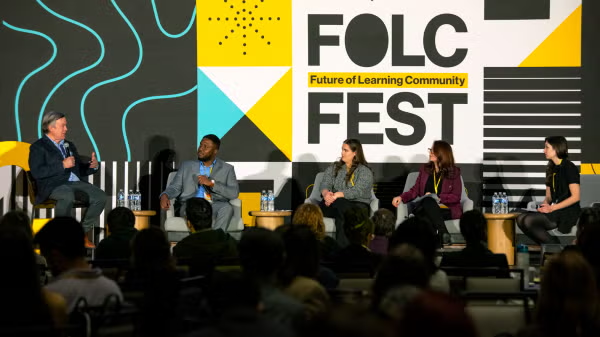
FOLC Fest 2025 explores Principled Innovation, leadership and learning at ASU
"Principled Innovation is about using our creativity, knowledge and resources to make decisions that ultimately benefit humanity — not just in the short term, but for generations to come."That's what…

These Sun Devils are inspiring the next generation of female athletes
This year, Women's History Month is celebrating the theme “Moving Forward Together! Women Educating and Inspiring Generations.”Women in sports inspire fans of all ages through their accomplishments…



